1) In what ways does your media product use, develop or challenge forms and conventions of real media products?
Ways in which our thriller incorporates generic conventions are chiefly through the use of cinematography. To start with, the protagonist and antagonist of all films needs to be identified to the audience in order for them to understand the characteristic qualities as well as being able to form their own opinion of them. As we only had a two minute time frame, one of the most important tasks was to establish the roles of the main characters. To accomplish the target of establishing the protagonist, Sergeant Smith is viewed through an extreme close up, a long shot showing the majority of his body along with an over the shoulder shot capturing his hand grasping the information being delivered. These shots instantly reveal that he has the stereotypical male role of being the provider which the audience feel safe with as his dialogue is concise and he carries a respectable posture. The extreme close up of his eyes set a serious atmosphere whilst the long shot displays his importance in the narrative.
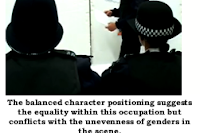
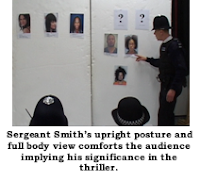
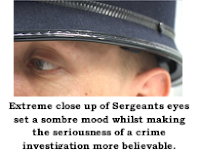
The similar shots used to film the antagonist, Ben Bullhorn, signifies alike meaning as he too is viewed through long shots, close ups and extreme close ups. The full body shots show Bullhorn dragging a heavy bag toward a car, which can be interpreted as disobedience of the male stereotype for his posture, hunched over, can be seen as him struggling. The close ups on the other hand, show evil and cold-hearted expressions which leave the audience feeling uneasy whenever they see him. Nevertheless, the similar use of shots convey the main characters by giving the sense that they are competing with each other, challenging one another for respect.


The use of conventions indicates a sub-genre through the use of mise on scene. For example, the choice of location being a garage with the view of cars where the antagonist conceals the body, suggest the film’s climax may feature a car chase between the police and fierce killer. This points in the direction of an action thriller film. But the use of props such as the arrangement of lilies placed on the victim’s body implies a hybrid genre of a psychological action thriller. As a group, our intention was to make the audience fear and feel disturbed by the antagonist. With our first decision to view him placing an arrangement of roses on the victim, we felt the symbolism would be misinterpreted by the connotation of him having a passionate emotion towards his victims. For this reason, we decided lilies were more appropriate as they are common flowers at funerals representing innocence, purity, and resurrection. They're often associated with the Virgin Mary and resurrection when placed on woman’s grave. This affects the audience as the vindictive behaviour of the killer shocks them into feeling uncomfortable because of his psychotic characteristics.

Other convention such as suspense was created by the use of score music. For example, the first time we are introduced to antagonist, Ben Bullhorn, the score music changes from high pitched mysterious sounding score to a heavy base and fast tempo track which sounds like a heartbeat. As the music climbs in volume, the tension builds and the audience are filled with panic putting them on the edge of their seat not knowing what he might happen next. As the diegetic use of dialogue makes a narrative outline more understanding, we made sure the language we chose belonged to the correct lexical field of crime. For example key words are used such as; ‘murdered, stabbed, victim, potential suspects and missing.’ This language makes the scene more realistic whilst deeply engaging the viewer.
2) How does your media product present particular social groups and how does it attract your audience?
Our media production represents particular social groups such as gender and race which we presented through our selection of cast. To begin with, the sequence opens with an establishing shot of a Metropolitan Police station. This unconsciously leads the audience to expect to see a male dominated scene due to the masculine occupation in the law enforcing field.

Their belief is supported as they are introduced to three police officers, two of which are male and one female. As the dialogue being delivered is by a male who is also the only character standing, the implication made is that males are dominant figures as he is providing the audience with the information needed to understand the narrative. The stereotypical view towards the male gender can also be seen as the ‘provider’ is also the only character to be viewed through a long shot in this scene. With this shot, the audience are aware of who holds the authority and are effected by feeling they can rely on this character which create enigmas as to whether he could be the hero of the narrative. Yet, this stereotypical outlook on gender can be interpreted in different ways due to the cinematic methods used. For example, the second shot of the sequence is a medium over the shoulder shot that shows both male and female trainee officers at the same level. This insinuates that the genders are able to be equal in this field of work especially as they are both viewed through close ups.

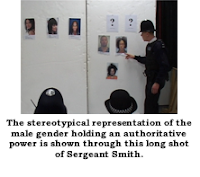

However, analysis of the juxtaposition of shots gives a different impression. As the sergeant announces the first victim who is female, the frame cuts to the close up of the female officer. I believe this is a strong connotation and feel the effect being imposed is a threatening atmosphere that makes the situation intimidating for her. This follows the female stereotype of not being capable for this profession without the male qualities. Further connotations of males indicate the stereotypical heroic view. As the sergeant announces the suspects, the frame cuts to a close up of the male officer which hints that he will be the rescuer of the narrative. The props used in this thriller opening also follow stereotypical characteristics as all the victims are females whilst the potential known suspects are male. This can be perceived that males have criminalist characteristics whilst females always appear to be the damsel in distress.
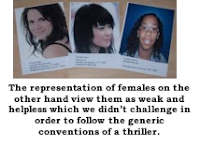
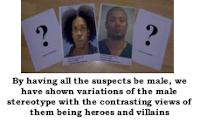
This led us to the decision of casting a male actor for the role of killer, Ben Bullhorn and another female actor for the recent victim, Rachel Brooke. By following these generalisations, the audience are able to relate to them as stereotypes are created within their own society, therefore we have visualised most people’s judgement in terms of gender. However, our thriller has challenged the common racial view point toward ethnic minorities. This can be seen as the antagonist is the same race as the police officers portraying the fact that there is good and bad in individuals not in particular races.
3) What kind of media institution might distribute your media product and why?
I think our thriller The Missing Suspects could be produced by a major Hollywood studio as the visual style reminds of a successful action thriller called Déjà Vu that features Denzel Washington as the protagonist. The high key lighting used at heroic moments conflicting with the under-toned mysterious use of colour at points of mystery, creates enigmas and suspense which keeps the audience fascinated throughout the film.
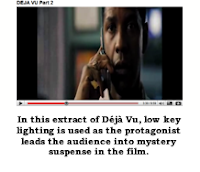
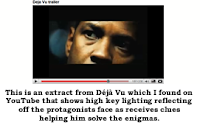
The choice us of producing a multi-strand narrative also shows that we are capable of illustrating different perspectives which demonstrates our mature style of production. I also think that by this institution distributing our product we will have the opportunity to distribute merchandise products. For example, a thriller such as The Godfather has the recognisable titles of ventriloquist strings representing the Godfathers control. Or, physiological thriller Fight Club’s poster of antagonist Brad Pitt with a conceited smile holding a bar of soap with blood smeared across the side of his face. These have a lasting impact on the audience as the posters are either have a symbolic meaning like The Godfather or, have a humorous perspective.
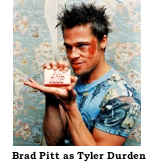
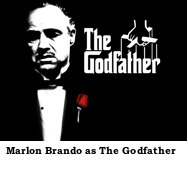
Using these as templates our thriller, The Missing Suspects, could distribute merchandise which could lead to a growth in profit. For example, t-shirts with antagonist Ben Bullhorn’s evil grinning expression, an arrangement of lilies in a vase of blood or a tall figure placing an arrangement of lilies on a grave. Here are two t-shirts I created as an example of what products we could produce from The Missing Suspects thriller. They both give the effect of a wickedness that the antagonist Ben Bullhorn presents as well as being recognisable; reminding the audience of his disturbing behaviour and the anxiety they felt whilst watching him.
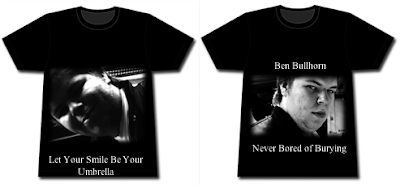
4) Who would be the audience for your media product?
According to the thriller questionnaires our group distributed, we received a lot of positive feedback from the contributors aged mostly between the ages of fifteen and eighteen. This therefore leads me to believe that The Missing Suspects could be enjoyed greatly by a target audience of fifteen to twenty-five year olds, especially females. My reason for this is that the common factor of all the victims being female could cause the audience to feel sympathetic, also, attracted to the thriller when they learn it’s a multi-strand narrative involving the law giving the gender they represent hope for saviour. However, I do think this thriller could attract people of an elder generation due to the use of police enforcing the law showing the effort put into making their environment a safer place. Following the rules made by the British Board of Film Classification and with this wide age range, our thriller has to be certified a fifteen. The guidelines appropriate for this certificate relating to thriller conventions are; strong threats and menace are permitted but the strongest gory images are unlikely to be acceptable whilst violence may be strong but may not dwell on the infliction of pain or injury. This means that if we were to continue producing a complete film of The Missing Suspects, some of the horrific themes would have to be connoted leaving the happening to the audience’s imagination.
5) How did you attract/address your audience?
Firstly, to address our audience we needed to know what in particular attracted them to the thriller genre. This led us to hand out questionnaires investigating their most favoured conventions, narrative themes and visual style. As we received positive feedback from the questionnaire which was completed mostly by young females, we decided to use this information to our benefit through the stereotypes representation of females. This casting decision could mean that the use of the victims being female will cause them to feel sympathetic toward the helplessly presented characters. This is supported by the cinematic technique used which puts the audience in the position of victim, Rachel Brooke, as the killer mulls over his kill in the boot of a car. This point of view shot weakens the audience and impacts them by experiencing the superiority the antagonist has leaning into the frame as if he is dominating the positioning of the camera himself. This creates suspense as the audience now feel they are in danger but engages them even further as they want to continue to watch the film to see if a hero can save us from this villain.

Other ways in which we attracted the audience is through the enigmas created. For example, as an establishing shot of the Metropolitan Police station is seen, the audience are instantly aware that a crime is under investigation at the beginning of the sequence however the question raised is; what crime has been committed? Other enigmas throughout the opening sequence produced are: Who are the missing suspects? Why has Rachel Brooke been kidnapped? What is Ben Bullhorn planning to do with Rachel’s body? These questions need to be answered which is what keeps the audience engaged; whilst the suspense created wont let them escape their curiosity. The suspense is constructed with the help of the fast high pitched score music and short close camera shots. We used these conventions often as facial close ups set the atmosphere with different expressions framed. Although our questionnaire revealed the majority of contributors preferred single-strand narratives, we were confident that the use of the police would attract the audience as the law enforcing element assures them of a solution.


6) What have you learnt about technologies from the process of constructing the product?
With the introduction of editing technologies such as Final Cut Pro, we were able to improve the frame’s mise en scene by using the effects the software had offered to portray conventions of a thriller. For example, the immediate establishing shot of the Metropolitan Police sign has been edited with a blue filter which instantly informs the audience of the thriller genre with its sinister effect.

This software has also allowed us to differentiate the themes of good and evil with further use of colour within the scenes of the police and the cold-hearted killer. When filming the police scene we noticed the high key lighting emitted a saintly effect. Therefore to show the contrast between characters, we came to the decision of making the killer’s scene low key in lighting. To do this, I as the editor, saturated the colour making the setting appear grimy and form shadows. The process of colour saturating was time consuming, although, I found it rewarding as the effect produces more meaning and symbolism.

After analysing many successful thrillers, it became clear that score music is a necessity in the aim of creating suspense. To achieve suspense, we selected score music with a high pitch, fast tempo and a heavy base from software called VideoCoPilot. By adjusting the length, volume and transitions between them on FinalCutPro, we aimed to narrate the storyline with a clear understanding. An example of this is when the volume had to be toned down as it is heard in the distance as the Sergeant delivers important information to the audience. If the volume was too high, the important information wouldn't have been heard, confusing the audience later in the film.

Other skills I’ve learnt through the use of Final Cut Pro are the effects that give our film a higher standard and the visual style of a professional film industry. For instance, the simple use of transitions between shots such as cross fading when showing the titles of the production can change the appearance dramatically.
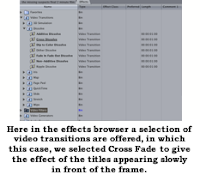
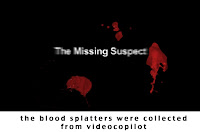
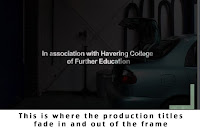 Overall, I’ve learnt that the effects you use are what categorize a film in a genre. Also, I’ve learnt that attention to detail needs to be shown during the editing process as the slightest break in continuity can sabotage the understanding of the narrative.
Overall, I’ve learnt that the effects you use are what categorize a film in a genre. Also, I’ve learnt that attention to detail needs to be shown during the editing process as the slightest break in continuity can sabotage the understanding of the narrative.Despite the positive outcome of the editing software, our group did experience challenges during the filming process which came as disadvantages. To begin with, our group had recorded a preliminary task which we then discovered had broken the 180degree rule. To resolve this dilemma we researched the cinematic technique by visiting YouTube.com and watching a visual guide explaining the correct methods. This helped us a lot as we gained full understanding of our misuse of the camera and put our new knowledge into practice by re-filming a preliminary task. This was more successful as we used a range of shots including shot reverse shot, close ups and medium shots as well as correct use of the 180 degree rule.
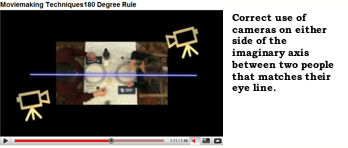
The cameras, PD170’s were reliable pieces of equipment although the use of them relied on the group members handing in call sheets and checking on their availability. I think this responsibility highlighted the dependable group members. We also endured many mistakes during our first attempt at filming an opening thriller sequence, The Axeman. Looking back in hindsight, compared to The Missing Suspects sequence our planning for this sequence wasn’t thoroughly thought through as we didn’t abide by a shot list and didn’t think about the appearance of props. The mise en scene did not convey the conventions of a thriller as the victim was seen wearing shiny jewellery, tied up by rope which the audience can clearly see her escaping herself from and the fake blood was undoubtedly red acrylic paint. There was no use of effects to give the feeling of an evil and fearful atmosphere. Consequently, from these errors, we learnt that when constructing a product it is essential that editing technologies are used to portray particular conventions of a genre.
7) Looking back at your preliminary task, what do you feel that you have learnt in the progression from it to the full product?
I feel I have learnt the importance of pre-production in filming as the mistakes we made caused us to review our decisions and improve creating a successfully represented thriller opening. The part that I enjoyed the most was the textual analysis and cinematic techniques in the thriller genre which made me realise the impact that miniscule details have on the audience. This for me broadened my horizons as the editor in creating a high standard production that followed as well as challenging thriller conventions. Since our first attempt of the preliminary task, the planning process became easier with the guide of a storyboard, a shot list as well as knowing the locations, type of score music and cast. When filming without this pre-planned construction, we found that we lost our agenda and spent more time discussing and altering decisions which led to the complication of the narrative storyline. The shot list in particular assisted our production as we knew exactly what shots were needed to be effective and relevant in our thriller. This also prevented our filming sessions from being prolonged as well as improving our shot types as there was no taking of unnecessary shots. This can be seen in the way the shots have been edited; short and concise, reflecting the conventions of a thriller. After all the practice with camera equipment and editing software, I now feel confident that we have produced an opening to a thriller that represents particular social groups as well as create suspense leaving a lasting impact on the audience.




